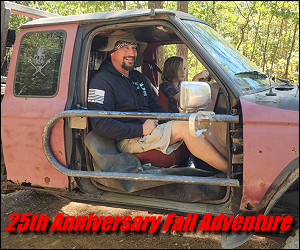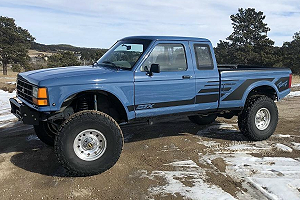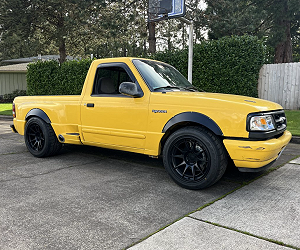Lift Laws Cont.
Maine
Headlights: Don't even think about going higher than 54 inches. However, keep in mind that the original suspension cannot be "disconnected", but don't let that stop you from bolting on heavy-duty shocks and overload springs. Other need-to-knows: Don't remove or disconnect the ABS, and the tires can be only two sizes larger than the manufacturer's recommendation. Spring-shackle extensions are also a no-no.
Maryland
No trucks or multipurpose vehicles with a GVWR of 10,000 pounds or less can be taller than 28 inches. A truck beyond 10,000 pounds-but not more than 18,000 pounds-can go beyond 30 inches (you Excursion owners just made it into that first grouping under the wire). Lift more than those 30, and you'll be ticketed and/or given a Safety Equipment Repair Order (SERO) to fix the violation.
Massachusetts
Get out your calculator: The maximum allowable mechanical lift (as well as what's acceptable in terms of bigger rubber) can be determined by this formula:
Maximum Lift = Wheelbase x Wheel Track
2200
For example, if you did that formula and came up with 2 inches, then a 2-inch lift and a 2-inch increase in tire size is allowable, equaling a total lift of 4 inches over stock.
Michigan
Lift blocks between the front axle and springs, or lift blocks that exceed 4 inches in height between the rear axle and springs, are not allowed. Shackle replacements cannot exceed the OE length by more than 2 inches, and ixnay on the coil-spring spacers. In terms of acceptable height, less than 4,501 GVWR, and your frame height cannot exceed 24 inches, and the bumper height can't go beyond 26 inches. For GVWRs between 4,501 and 7,500, those numbers are 24 and 28 inches. For 7,501- to 10,000-pound vehicles, keep the height at 26 and 30 inches.
Minnesota
The maximum legal height for bumpers is 25 inches from the bottom of the bumper to the ground. If you attach something to the bumper to make it conform to the legal height, it must be just as strong as the factory bumper or meet SAE standards. Simply bolting on pieces of wood or metal isn't gonna cut it, folks. If you slap on a lift kit, you might actually be required to register your truck as a "reconstructed" vehicle, and that would mean you'll have to pay an additional road-use tax and need an inspection where a new VIN would be applied.
Mississippi
No vehicle can be modified in any way that will put it over the state's 8-inch total-lift limit, and the maximum suspension lift front and rear is 6 inches (so make sure your big tires won't be over the limit if you raise the suspension that much).
Missouri
Here's another state that uses the GVWR as the bumper-height guideline. For vehicles 4,500 pounds and under, the front bumper can't be taller than 24 inches and the rear must see no more than 26 inches. For 4,501 to 7,500 pounds, it's 27 inches front and 29 rear, and for 7,501 to 9,000 pounds, it's 28 and 30 inches.
Montana .
No laws here, but your truck will need to meet the lighting requirement, which is that headlights are no higher than 72 inches or lower than 15 inches.
Nebraska
There aren't any specific laws concerning lift kits, but mudflaps get all the attention. They must block the entire width of the tires.
Nevada
We'll cut to the chase: The bumper height, be it front or rear, cannot go beyond 24 inches.
New Hampshire
No vehicle's height (and we're talking loaded too) may be taller than 13 feet 6 inches. Don't change the height or alter the bumper in any way that would make it farther than 30 inches from the ground.
New Jersey
You can raise the suspension only 4 inches above stock height. Go any higher and your truck becomes classified as a "High Rise" and it must undergo a stability.test at a state facility.
New Mexico
The restrictions this state has are that headlamps can't be higher than 54 inches, and taillamps can't be higher than 72 inches. However, it's no-holds-barred on the type of Iift used.
Now York
AII 1990-and-newer commercial vehicles and trucks can't go crazy and get that bumper above 24 inches from the ground. Also keep in mind that headlights must not be more than 54 inches above the cement, and taillights can't be higher than 72 inches. Turn-signal lights can't exceed 83 inches.
North Carolina
Don't even think about going higher than 6 inches from the factory height-unless, of course, you get a written OK from the Commissioner of Motor Vehicles. You don't need a permission slip if yours is a multipurpose ride atop a truck chassis that sees some dirt.
North Dakota
A height of 14 feet, loaded or unloaded, is the limit. Keep in mind that if your tires poke out from the body, you're best advised to stick on fender flares to keep the police at bay.
Ohio
This state keeps an eye on the GVWR for bumper height. For 4,500 pounds and under, 24 inches is the max at the front, 26 at the rear, and 4,501 to 7,500 is 27 to 29. For 7,501 to 10,000, it's 28 and 31 inches. If the body or truck-bed height is altered, the difference in height between the body floor and/or the bed floor to the top of the framerail can be no more than 4 inches.
Oklahoma
Before you pick out that lift kit, keep in mind that headlights can be no more than 54 inches from the ground, and the taillights' can't exceed 72 inches.
Oregon
Oregon doesn't have a maximum bumper-height law, but headlights can be only 54 inches from the center of the headlight to the asphalt. Also, the maximum height of a vehicle, with anything on top or loaded, is 14 feet.
Pennsylvania
Be aware that increasing the wheel track by using spacers or similar doodads thicker than 1/4 inch is a very bad move. On medium and heavy-duty trucks, the rear bumper must be within 30 inches of the ground when the truck is unloaded.
Rhode Island
For all vehicles with a 10,000-pound GVWR or less, you can raise the chassis or body no more than 4 inches from the OE height.
South Carolina
You can't modify either up or down by more than 6 inches from the original height.
South Dakota
There aren't regulations for the suspension, per se, but the taillights can be no higher than 72 inches.
Tennessee
There can be no more than 4 inches between the body floor and the top of the frame. The distance between the bumper and the ground is 24 inches for GVWRs of 4.500 and less; 26 inches for 4,501 to 7,500; and 28 inches for 7,501 to 10,000.
Texas
Laws concern lighting but not bumper height or even lift blocks. The headlamps must be mounted between 24 and 54 inches from the ground, the taillamps between 15 and 72, and the foglamps between 12 and 30.
Utah
After being told it's a "mathematical nightmare" to figure out by one local trooper, we got the scoop from another trooper: If your vehicle's wheelbase is 100 inches or less, the most you can lift can be determined by:
Maximum Lift =
Wheelbase x Wheel Track
2200
For 4x4 wheelbases beyond 100 inches, you can lift a total of 8 inches, butyou'll have to remember your new tires do that equation (so if you lift 4-inches, you can go up in tire size that much too).
Vermont
For trucks and multipurpose vehicles, the allowable bumper-height increase for front bumpers and rear bumpers depends on the GVWR. For 4,500 pounds and under, it's 24 inches front and 26 inches rear. For 4,501 to 7,500, it's 27 and 29, and for 7,501 to 10,000, it's 28 and 31.
Virginia
Don't even think about driving on these highways if there are more than 28 inches between the bumpers and the road if your truck falls in the 4,500-pound GVWR rating. For 4,501 to 7,500 pounds, the front bumper must stay lower than 29 inches and the rear 30 inches; for 7,501 and 15,000 pounds, it's 30 at the front and 31 at the rear.
Washington
You can lift your truck in Washington without fear, as long as the kit is manufactured by an aftermarket company and is designed for your make and model of truck, as well as installed the right way. You know this already, right? Right?! Body lifts can't use more than a 3-inch spacer and are not allowed to raise the body more than 4 inches above the frame after all the components are installed.
West Virginia
The most space you can have between the body and the frame is 3 inches, while the acceptable gap between the bumpers and the ground is 31 inches for a 10,000-pound GVWR or less. More weight than that, you're free and clear.
Wisconsin
Wisconsin law says that vehicles with up to an 8,000-pound GVWR can be pushed 5 inches above the OE height, and the tires can be increased by up to 4 inches in radius over the factory size, equaling an acceptable 9-inch lift.
Wyoming
There are no official statutory guidelines for bumper height, frame height, rear blocks, or shackle lifts-all laws referring to these alterations say vehicles must simply be in "safe" working condition.


















